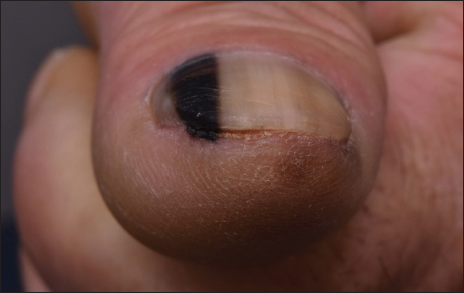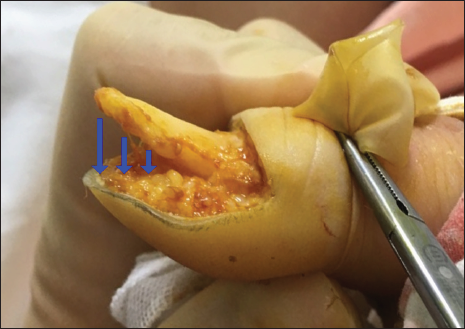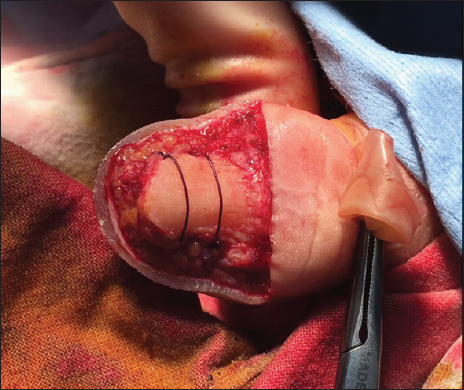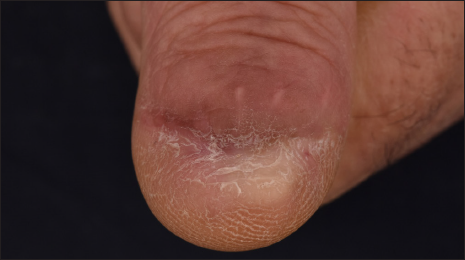Translate this page into:
A simple technique in en bloc nail excision with phalangeal bone detachment
Corresponding author: Jee Woong Choi, Department of Dermatology, Ajou University School of Medicine, Suwon, Korea. dermaboy@gmail.com
-
Received: ,
Accepted: ,
How to cite this article: Park HS, Choi JW. A simple technique in en bloc nail excision with phalangeal bone detachment. Indian J Dermatol Venereol Leprol. 2024;90:133-4. doi: 10.25259/IJDVL_254_2023
Surgical Challenge
En bloc nail excision, or functional surgery, is widely performed for malignant nail tumours.1 In most cases, defects from excision can be covered with full-thickness skin grafts.2 However, it is difficult to make a stable recipient bed in complex cases. When a malignant tumour invades the hyponychium, phalangeal bone, and underlying soft tissue, detachment is unavoidable for adequate surgical margin control. This results in an unsuitable recipient bed with limited soft tissue and contour irregularity [Figures 1 and 2a]. These cases are often handled with a free flap, with additional wounds and costs. Herein, we present an easy technique to gain enough graft beds with simple sutures.

- Preoperative photo shows melanoma in situ invaded hyponychium of the left thumb. Removal of soft tissue beneath the phalangeal bone is needed for adequate margin control.

- Detachment of bone and soft tissue. Due to hyponychium invasion of melanoma in situ, phalangeal bone and inferior soft tissue are necessarily detached for the achievement of adequate safety margin. For skin graft, stable adherence of bone and soft tissue is needed.
Solution
When a phalangeal bone is detached from the underlying soft tissue, it is challenging to keep the graft stable [Figure 2a]. We attached the bone to the underlying soft tissue to prepare for the recipient bed by simply suturing them with 4-0 Vicryl. Two sutures were enough to make the fixation stable [Figure 2b]. Then, the full-thickness skin grafting can be performed on the prepared recipient bed to cover the wound. Sutures do not need to be removed as they will be absorbed spontaneously.

- Post-fixation of phalangeal bone and underlying soft tissue with 4-0 Vicryl.
The method we propose tightens inferior soft tissue to provide enough attachment surface. Phasing out the dead space may also reduce the chances of hematoma formation, which can induce necrosis of the overlying skin graft. This technique enables the achievement of adequate surgical margins with satisfactory functional and cosmetic outcomes, without amputation or a complicated free flap procedure [Figure 3].

- Postoperative result after 4 months.
Declaration of patient consent
The authors certify that they have obtained all appropriate patient consent.
Financial support and sponsorship
Nil.
Conflicts of interest
There are no conflicts of interest.
References
- Conservative surgical management of subungual (matrix derived) melanoma: report of seven cases and literature review. Br J Dermatol. 2011;165:852-8.
- [CrossRef] [PubMed] [Google Scholar]





